The Best Flowers For Winter – Plants that Flower in Winter (With Pictures)
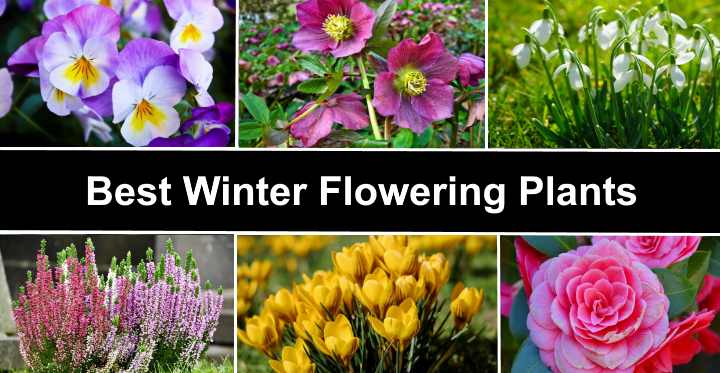
Plants that flower in the winter add plenty of color to a barren garden landscape. Colorful winter flowering plants continue to bring life to gardens when other plants don’t grow. Many types of perennial flowers, annual flowers, bulbous plants, and flowering shrubs survive winter and continue to produce blooms in various colors.
After some late bloomers finish flowering in the fall, winter flowers will keep color in your garden. Planted along borders, in mixed flower beds, along driveways, or in pots on patios or decks, plants that last throughout winter will keep your garden alive. You can enjoy winter flowers in hues of blue, yellow, orange, pink, purple, red, and white. Of course, you can also plant evergreen shrubs to add greenery to winter landscapes.
This article is a guide to finding the best winter flowers for your garden. If you choose wisely, your front or backyard will have plants that grow in winter and bloom between November and March.
Where to Plant Winter Flowers
You can grow winter flowering plants in many climates, even in cold regions. Although it’s easier to find plants that survive winter in warmer areas, there are plenty of cold-hardy plants to choose from. When selecting the best flowers for growing in winter, there are a few things to keep in mind.
First, you should check the USDA zone where you live. Some types of winter plants may die off in the extreme cold. Or some flowering plants grow as annuals in northern states but are perennials in warmer zones.
Second, you should consider how much light the plants need to bloom. Some winter bloomers need plenty of sunlight. In some cases, you need to plant bulbs or shrubs in the ground long before winter arrives to give the roots time to establish themselves.
When to Expect Winter Flowering Plants to Bloom
The time when cold-hardy flowering plants start blooming depends on the type of flower, climate, and sun exposure. For example, some resilient bulbous plants start flowering in late winter as the snow melts. Some perennials in milder climates will have flowers throughout the winter.
You may have to wait until February or March for blooms to appear on winter plants in colder regions. In areas with milder winters, you could see the first flowers appearing in December or January.
If you grow winter flowering annuals, you may have to plant them near the end of summer or beginning of fall to enjoy flowers during winter. It’s also good to remember that some winter flowering bulbs need a cold snap to bloom.
Winter Flowers – Plants that Blossom in Winter
Here are 17 winter flowers that actually blossom in the winter.
Winter Pansies (Viola hiemalis)
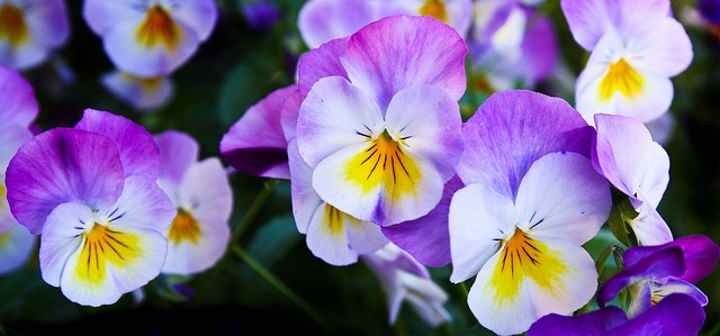
Pansies are plants that flower throughout fall and winter and will display a stunning array of color
Winter flowering pansies are some of the best outdoor winter plants because of their colorful flowers that bloom in winter. Pansies are hardy plants that produce winter flowers in spectacular colors such as yellow, deep purple, and orange. There are even pansies that have black flowers. For cold-hardy flowering pansies, choose varieties of Viola hiemalis, which will bloom throughout mild winters.
Due to their tolerance to cold, winter pansies are also called ice pansies.
For stunning fall and winter colors, plant pansies as annuals in cold climates. Pansies are excellent winter plants to grow in pots or in the ground outdoors.
The best time to plant pansies is in September. You may get flowers appearing in the fall and sometimes during November and December. The delightful flowers will then make a stunning floral display in early spring.
The low-growing garden pansies thrive in cooler temperatures in USDA zones 4 through 7.
Christmas Rose (Helleborus niger)

You can grow Christmas rose as a winter flower to brighten a shady area in your garden
Christmas rose produces magnificent white flowers in winter around the end of December. The cup-shaped flowers are 3” (8 cm) across and grow at the end of long stems. As an evergreen perennial, Christmas rose comes to life when the weather cools. Christmas rose is an ideal winter perennial for growing in full to part shade.
Christmas rose grows best in shady borders, under shrubs, or in mixed beds. Christmas rose is also an excellent ground cover plant for shade and a winter flowering plant for pots.
Christmas rose thrives in USDA zones 3 through 8.
Lenten Rose (Helleborus x hybridus)
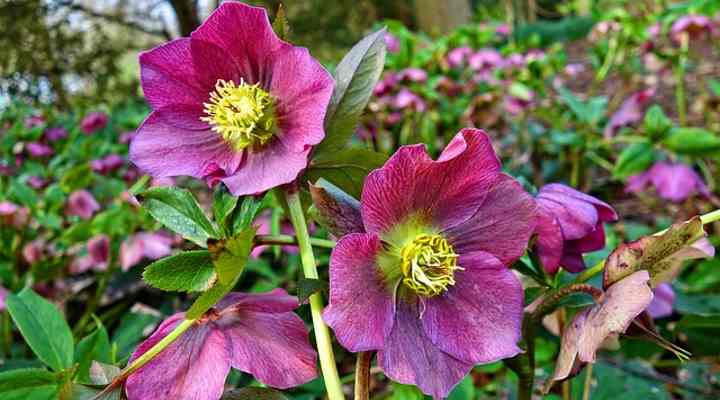
Lenten rose can be grown as an outdoor winter flowering plant to enhance the landscaping of shaded locations
Lenten rose is also called winter rose and is a clump-forming perennial that produces flowers in mid or late winter and early spring. Lenten rose produces winter flowers that are in shades of red, yellow, white, pink, and purple. In freezing climates, this Helleborus hybrid may start flowering in spring, around the time of Lent.
Lenten rose is a winter plant that grows best in shady locations under shrubs or trees. The spreading plant is also suitable for ground cover, where its evergreen foliage adds greenery to bare ground in winter.
Lenten rose thrives in USDA zones 3 through 8.
Winter Aconite (Eranthis hyemalis)
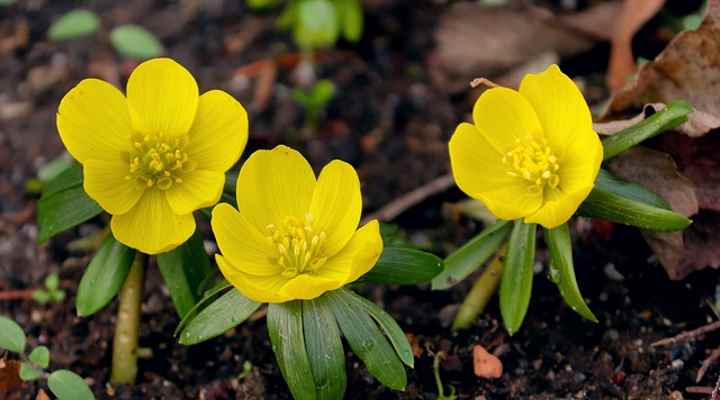
Winter aconite is a great outdoor cold hardy plant with small pretty yellow flowers
Winter aconite blooms in late winter with small, bright yellow flowers that look like buttercup flowers. As a cold-hardy plant, winter aconite usually pushes up flowers while there’s still snow cover on the ground. The small winter aconite plant grows up to 6” (15 cm) tall, and the green leaves appear after the plant has flowered in winter.
Winter aconite is a perennial flower that should be planted in fall. To flower year after year, the ground needs to be continuously moist, even though its growth goes dormant in spring. Winter aconite dies back in spring to its tuberous roots.
Winter aconite grows in USDA zones 3 through 7.
English Primrose (Primula vulgaris)

You can grow English primrose as a winter flowering plant in pots or as an outdoors ground cover
English primrose is a semi-evergreen flowering plant that grows fragrant yellow flowers from late winter until mid-spring. As a low-growing flowering plant, English primrose is ideal for colorful ground cover during winter. The pale-yellow round flowers have a golden yellow center.
English primrose is a hardy winter plant that grows best in partial shade or full sun in cool summers. Grow the hardy English primrose plant in borders, mixed flower beds, or rock gardens. Primula vulgaris is also suitable as a winter plant for growing in pots outdoors.
English primrose thrives in USDA zones 4 through 8.
Winter Jasmine (Jasminum nudiflorum)
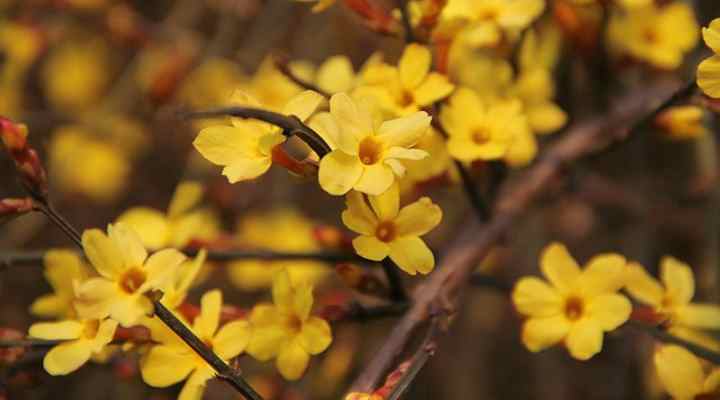
Winter jasmine is a cold weather flowering shrub with small yellow flowers
Winter jasmine is a shrub that flowers in winter with beautiful star-shaped yellow flowers growing on long dangling branches. The slender vine branches produce masses of flowers in late winter or early spring. Winter jasmine grows around 4 ft. (1.2 m) tall, and its vining stems reach up to 15 ft. (4.5 m).
Winter jasmine is native to China, where its name means “the flower that welcomes spring.” Being a flowering winter vine, winter jasmine’s blooming time is from November to March.
Winter jasmine thrives in USDA zones 6 through 9.
Camellia (Camellia japonica)
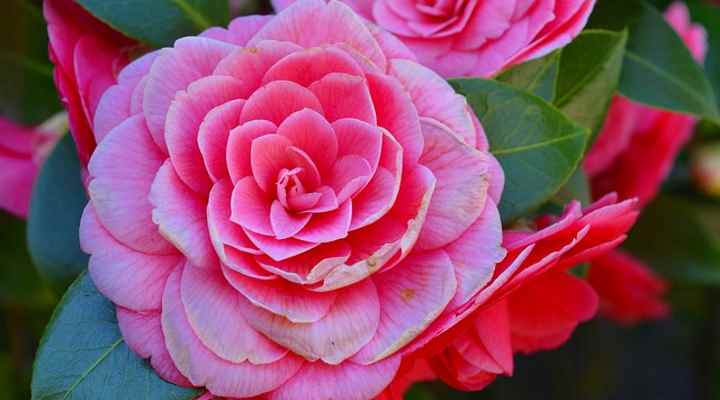
Camellia japonica is a hardy shrub that flowers in winter with stunning blooms
Cold-hardy Japanese camellia plants produce stunning winter flowers that are single, double, or peony-like showy blooms. The hybrid Camellia japonica has spectacular floral displays in late winter or early spring. Depending on the Camellia species, the winter blooms can measure between 1.5” and 5” (4 cm – 12 cm).
Due to its stunning flowers, Camellia japonica is also called winter rose. Depending on the climate and cultivar, the pink, red, and multi-colored flowers last for up to five months.
Before choosing which winter shrub to plant in your backyard, check the cold hardiness of the cultivar. Cultivars that bloom in late winter include ‘April Blush,’ ‘April Remembered,’ Korean Fire,’ and ‘Pink Icicle.’
Flowering Camellia japonica shrubs are cold-hardy for USDA zones 6 through 9.
Winter Honeysuckle (Lonicera fragrantissima)

The attractive white flowers of winter honeysuckle are a great addition to the outdoor winter garden
Winter honeysuckle is an ornamental winter flowering shrub with small, fragrant white flowers that appear from January through March. This “harbinger of spring” grows between 3 and 10 ft. (1 – 3 m) tall. The deciduous flowering winter shrub has a bushy growth and is an ideal addition to gardens to add color to yards at the start of the year.
Other names for winter honeysuckle include fragrant honeysuckle, January jasmine, and Chinese honeysuckle.
Winter honeysuckle grows and flowers in USDA zones 4 through 8.
Flowering Winter Heath (Erica × darleyensis)
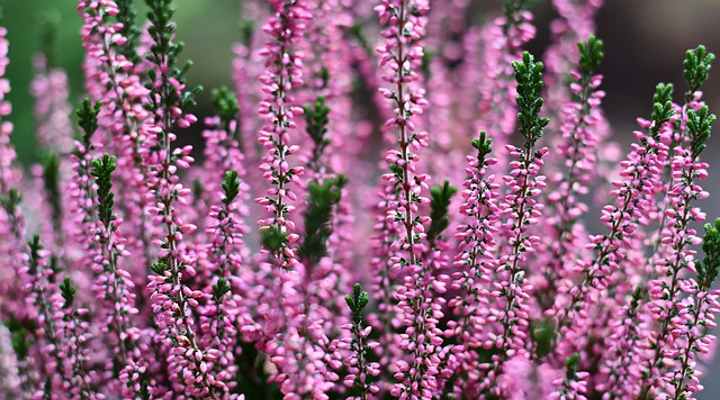
The flowers of Winter heath add decorative touch during winter when other plants don’t survive the cold weather
Winter heath is a small, bushy flowering evergreen shrub that blooms in winter with masses of tiny purple-pink flowers from November through April. Winter heath is from the heather family and is an easy-care, hardy plant that thrives just as well in the heat as it does in freezing weather. The evergreen foliage provides greenery throughout the summer when planted in full sun.
Also called Heather ‘Darley Dale,’ winter heath grows best in containers, rock gardens, as a winter border shrub, or foundation planting. Due to its spreading nature, winter heath is also an ideal ground cover plant for full sun to add color to bare ground during winter.
Winter heath grows in USDA zones 6 through 8.
Japanese Andromeda (Pieris japonica)
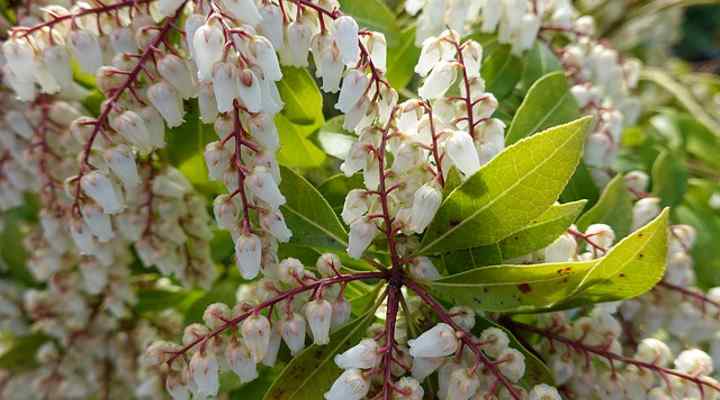
Japanese Andromeda is an ornamental winter flowering shrub that provides interest all year long
Japanese Andromeda is an evergreen, late-blooming shrub with winter flowers. The flowering shrub has attractive flower buds that grow in summer and fall. Then large dangling clusters of white or pink flowers appear at the end of winter. By March, the shrub is in full bloom.
Japanese Andromeda is a large broad-leafed shrub or small tree that grows between 9 and 13 ft. (2.7 – 4 m) tall. The spreading plant adds year-round interest thanks to its glossy evergreen foliage, winter flowers, and colorful summer and fall bead-like buds.
Due to the drooping clusters of the pink or white flowers, the Japanese Andromeda is also called the lily-of-the-valley bush.
Japanese andromeda is suitable for planting in USDA zones 4 through 8.
Witch Hazel (Hamamelis)
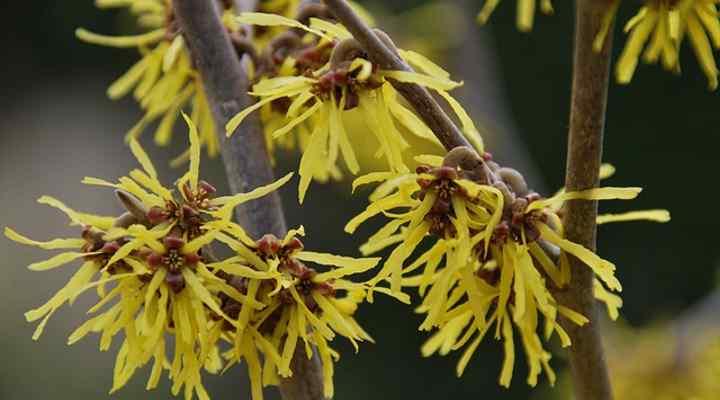
Some witch hazel species are cold tolerant and provide cheerful winter blooms
Winter flowering witch hazel can start blooming as early as the end of December. Clusters of wiry golden yellow flowers appear on the woody stems, with most of the cold-hardy witch hazel plants in full bloom by mid-January. To plant winter-blooming witch hazels that survive frost, look for the Chinese and Japanese varieties of Hamamelis plants.
Hamamelis mollis, Hamamelis japonica, and Hamamelis vernalis are types of cold-hardy witch hazels with winter blooms.
Witch hazel is a large deciduous shrub that grows between 10 and 15 ft. (3 – 4. 5 m). The crinkly, ribbon-like flowers turn the bush a yellow color when in bloom at the end of the year and the start of the new year.
Witch hazel thrives in USDA zones 3 to 8. For a winter-blooming variety, check to make sure that it is in flower between November and March.
Clematis (Clematis cirrhosa)

Clematis is a climbing plant that flowers in winter. This plant is suitable for planting if you live in areas where winter is not too cold
Clematis cirrhosa is a winter-flowering evergreen climbing vine. It produces showy bell, star, or saucer-shaped winter flowers in blue, pink, and white shades. In warmer climates, Clematis cirrhosa blooms profusely from January onward. The climbing nature of clematis makes this early bloomer ideal for covering arbors, trellises, arches, or fences with winter flowers.
This Clematis species isn’t ideal as a flowering plant for extreme winters. To enjoy its winter flowers in cold climates, Clematis cirrhosa is a good winter plant for pots.
Clematis cirrhosa thrives in USDA zones 7 through 11.
Cyclamen
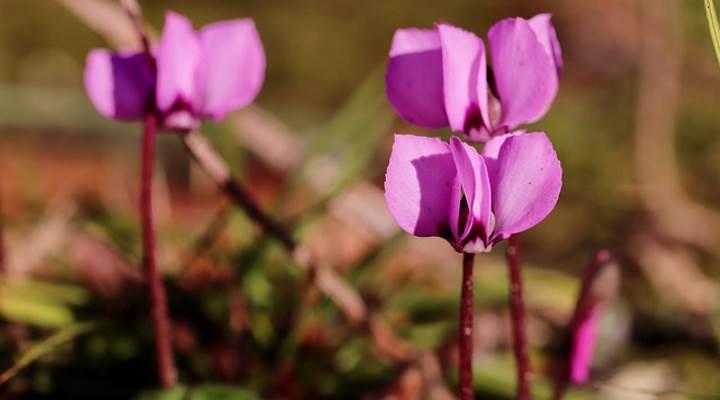
Persian cyclamen (in the picture) is the best type of cyclamen to grow outdoors in cold winter because it’s the hardiest of the cyclamen varieties
Cyclamen is a perennial flowering plant genus with many species that flower in winter and spring. Cyclamen plants have attractive flowers with delicate, colorful petals that seem to point upward. The vibrant winter flowers are in pink shades, from bright, vibrant pink to soft pastel pink and white colors.
The cold-hardiest varieties of Cyclamen that flower in winter are the Persian violet (Cyclamen coum) varieties that grow outdoors in zone 4 through 8. However, most species of Cyclamen prefer cool temperatures and bloom in winter.
Because most Cyclamen flowers don’t tolerate frost, the plants are best growing in pots. This way, you can display your winter flowers outside in cold weather, as long as it’s not below 32°F (0°C). Then bring them indoors in summer when the weather gets hot.
Only the Persian violet (Cyclamen coum) plants are cold-hardy flowering plants to grow outdoors in winter. So, it’s always best to check the suitable growing zones. For example, the Persian cyclamen (Cyclamen persicum) is a winter bloomer but is only suitable for zones 9 through 11.
Snowdrops (Galanthus nivalis)
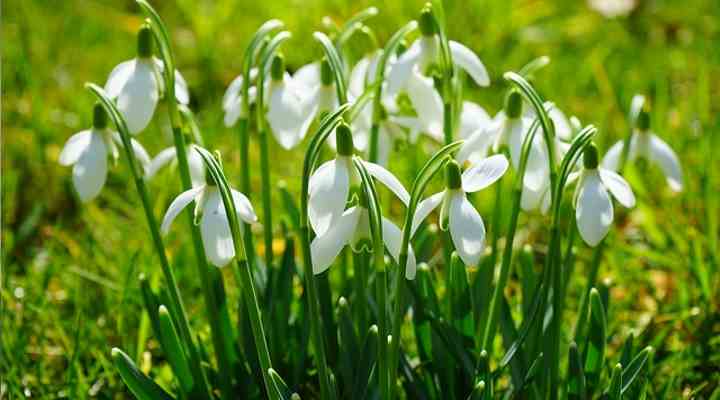
Snowdrop is a cold hardy bulbous plant that blooms in late winter with delicate white flowers
Snowdrop forms blankets of white bell-shaped flowers at the end of winter. Snowdrop is one of the first bulbous plants to bloom in late winter and early spring. The small pendulous winter flowers dangle from short green stems, 8” to 10” (20 – 25 cm) tall. The clumping flowers come back every January until April.
Snowdrop is a species of low-maintenance perennial plant that survives winter. You don’t need to deadhead the flowers, and the foliage dies back before regrowing at the end of the next winter. Plant snowdrop flowers along borders, under trees, or in containers.
Snowdrops are cold-hardy in USDA zones 3 through 8.
Glory of the Snow (Chionodoxa)

You can enjoy the dainty flowers of glory of the snow bulbs during winter year after year
Glory of the snow is a hardy perennial bulbous plant that blooms in winter while there is still snow on the ground. Chionodoxa flowers come up early in spring and are one of the first you’ll see. Glory of the snow flowers are delicate star-shaped lilac or purple flowers with a white center.
The Chionodoxa tuberous roots survive harsh frosts, and the perennial flowers return year on year. The thin green foliage and flowers grow between 4” and 6” (10 – 15 cm) and thrive in full sun.
Glory of the snow plants (Chionodoxa) thrive in USDA zones 3 through 8.
Snow Crocus (Crocus chrysanthus)
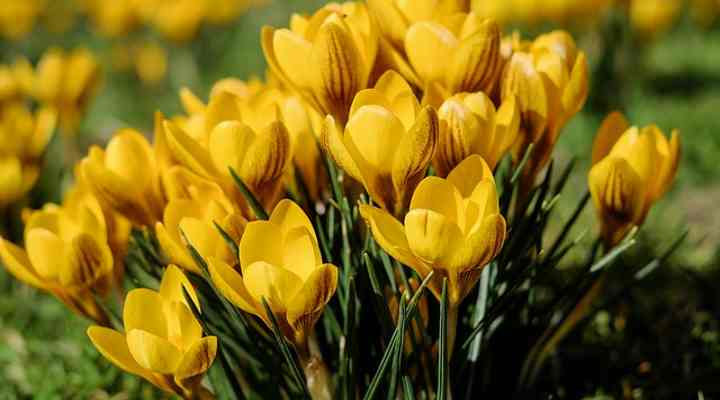
Snow crocus bulbs produce cold weather flowers in late winter or early spring
Snow crocus grows in clumps and starts flowering in winter even when snow covers the ground. You can expect to see flowers appear in late winter or early spring. Usually, crocus bulbs that stay in the ground from year to year flower earlier in winter than other crocuses.
The snow crocus is a low-growing flowering winter plant. The small clumps of tulip-like flowers grow between 3” and 4” (7 – 10 cm). The best place to plant winter crocuses is in full sun or partial shade. Crocuses grow best along borders, in rock gardens, or lawns.
Snow crocuses are hardy perennials with flowers that come back every year.
Snow crocus is suitable for USDA zones 3 to 8.
Algerian Iris (Iris unguicularis)
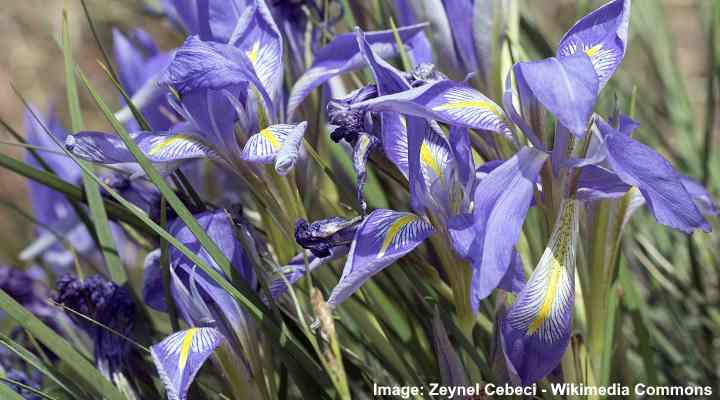
The hardy Algerian iris grows in winter with beautiful display of purple flowers
Algerian iris is a hardy perennial plant that flowers from late fall through winter until early spring. Evergreen winter iris plants have fragrant flowers in shades of purple and violet. The large, showy winter flowers are between 2” and 3” (5 – 8) wide, sitting on the top of 1 to 2-foot (30 – 60-cm) stems.
Algerian iris continues to grow in temperatures as low as 5°F (-15°C). The bulbous winter flowers bloom when little else grows in gardens. Algerian iris grows best in full sun and enjoys well-drained soil. Once established, this species of iris is a drought-tolerant plant.
Algerian iris thrives in USDA zones 7 through 9.
Related articles:
